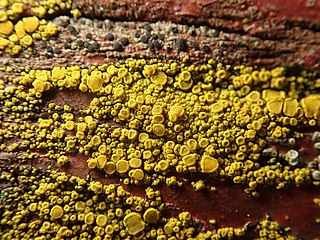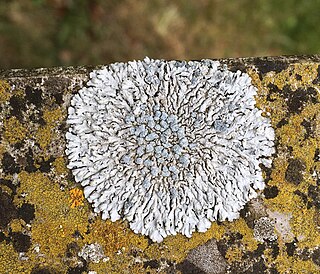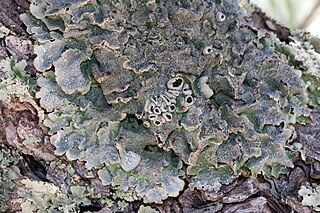
Chaenotheca is a genus of lichenized fungi within the family Coniocybaceae. The sexual reproduction structures are a mass of loose ascospores that are enclosed by a cup shaped exciple sitting on top of a tiny stalk, having the appearance of a dressmaker's pin, hence the common name pin lichen. Genus members are also commonly called needle lichens.

Dermatocarpon is a genus of lichens in the family Verrucariaceae.

Hypogymnia is a genus of foliose lichens in the family Parmeliaceae. They are commonly known as tube lichens, bone lichens, or pillow lichens. Most species lack rhizines that are otherwise common in members of the Parmeliaceae, and have swollen lobes that are usually hollow. Other common characteristics are relatively small spores and the presence of physodic acid and related lichen products. The lichens usually grow on the bark and wood of coniferous trees.

Myelochroa is a genus of foliose lichens in the family Parmeliaceae. They are commonly known as axil-bristle lichens. It was created in 1987 to contain species formerly placed in genus Parmelina that had a yellow-orange medulla due to the presence of secalonic acids. Characteristics of the genus include tightly attached thalli with narrow lobes, cilia on the axils, and a rhizinate black lower surface. Chemical characteristics are the production of zeorin and related triterpenoids in the medulla. Myelochroa contains about 30 species, most of which grow on bark. The genus has centres of distribution in Asia and North America.

Punctelia is a genus of foliose lichens belonging to the large family Parmeliaceae. The genus, which contains about 50 species, was segregated from genus Parmelia in 1982. Characteristics that define Punctelia include the presence of hook-like to thread-like conidia, simple rhizines, and point-like pseudocyphellae. It is this last feature that is alluded to in the vernacular names speckled shield lichens or speckleback lichens.

Candelariella is a genus of bright yellow, ocher, or greenish yellow crustose or squamulose lichens in the family Candelariaceae. Members of the genus are commonly called eggyolk lichens, goldspeck lichens, or yolk lichens. The genus was circumscribed in 1894 by Swiss lichenologist Johannes Müller Argoviensis, with Candelariella vitellina assigned as the type species.

Nodobryoria is a genus of medium to large, reddish-brown lichens that are hair-like to shrubby in shape and grow on conifer trees. The genus contains three species, distributed in North America and Greenland, which were previously included in the genus Bryoria. Nodobryoria is similar in appearance to Bryoria, but is differentiated because it does not contain the polysaccharide lichenin, and it has a unique cortex composed of interlocking cells that look like pieces of a jigsaw puzzle when viewed under a light microscope.

Chrysothrix is a genus of lichen-forming fungi in the family Chrysothricaceae. They are commonly called gold dust lichens or sulfur dust lichens, because they are bright yellow to greenish-yellow, sometimes flecked with orange, and composed entirely of powdery soredia. Apothecia are never present in North American specimens.

Physcia caesia, known colloquially as blue-gray rosette lichen and powder-back lichen, is a species of foliose lichenized fungus. First described by Georg Franz Hoffmann in 1784, it is common across much of Europe, North America and New Zealand, and more patchily distributed in South America, Asia, Australia and Antarctica. There are 2 subspecies: P. c. caesia and P. c. ventosa, as well as a number of distinct forms and varieties. Molecular studies suggest that the species as currently defined may be polyphyletic. It is typically pale gray shading to darker gray in the center, and grows in a small rosette, usually some 2–3 cm (0.79–1.18 in) across at maturity. It only rarely has apothecia, instead reproducing most often vegetatively via soredia, which are piled in round blue-gray mounds across the thallus's upper surface. It grows most often on rock—principally calcareous, but also basaltic and siliceous—and also occurs on bone, bark and soil. It is nitrophilic and is particularly common on substrates where birds perch.
Robert "Bob" Shaw Egan is a botanist and lichenologist, specializing in the family Parmeliaceae. He was the president of the American Bryological and Lichenological Society from 1999 to 2001.

Punctelia rudecta, commonly known as the rough speckled shield or the speckleback lichen, is a North American species of foliose lichen in the family Parmeliaceae. This species can be readily identified by the light color of the thallus underside, the relatively large lobes at the edges of the thallus, and the tiny white pores present on the top of the thallus that are characteristic of the genus Punctelia. The lichen is quite abundant and widespread in the eastern and southeastern United States, although it also occurs in Canada and northern Mexico, but is less common in these regions. The lichen usually grows on bark, and less commonly on shaded rocks. There are several lookalike Punctelia species; these can often be distinguished from P. rudecta by differences in distribution or in the nature of the reproductive structures present on the thallus.

Punctelia hypoleucites, commonly known as the southwestern speckled shield lichen, is a species of foliose (leafy) lichen in the family Parmeliaceae. First formally described by Finnish botanist William Nylander as a species of Parmelia, it was transferred to the genus Punctelia in 1982. The lichen is found in Africa, North America, and South America, where it grows on the bark of both hardwood and coniferous trees. Its greenish-grey thallus is covered with tiny white pseudocyphellae – minute holes in the thallus surface that facilitate gas exchange. Some macroscopic features that help distinguish this species from other related members of the genus include the presence and the structure of the apothecia, the absence of asexual surface propagules, and the light brown color of the thallus undersurface. Chemically, the presence of lecanoric acid in the medulla and atranorin in the cortex help distinguish it from lookalikes.

Punctelia bolliana, the eastern speckled shield lichen, is a species of foliose lichen in the family Parmeliaceae. It is found in North America, with a distribution extending from the Canadian province of Ontario south to the central and northeastern United States and Mexico. It grows on the bark of both deciduous trees and coniferous trees. The combination of characteristics that distinguishes this species from others in genus Punctelia are the absence of the vegetative propagules isidia and soralia, a pale brown lower thallus surface, and the presence of the secondary chemical protolichesterinic acid in the medulla.

Punctelia graminicola is a species of foliose (leafy) lichen in the family Parmeliaceae. It grows on rocks, and, less frequently, on bark in North America, South America, and East Africa. It has a blue-grey thallus measuring up to about 15 cm (6 in), covered with tiny pores called pseudocyphellae. Sometimes the lichen forms small lobes that project out from the surface. Fruiting bodies are uncommon in this species; if present, they resemble small cups with a brown internal disc measuring 3–10 mm (0.1–0.4 in) in diameter. A lookalike species, Punctelia hypoleucites, is not readily distinguishable from Punctelia graminicola by appearance or habitat alone; these species can only be reliably differentiated by examining the length of their conidia.

Loxospora ochrophaea is a species of crustose lichen in the family Sarrameanaceae.

Ramalina americana, commonly known as the sinewed ramalina, is a pale green fruticose lichen that is found across the Northern US Midwest, extending into Southern Canada and the Eastern Seaboard. It is characterized morphologically by the presence of pseudocyphellae, straight spores, and its unique chemical diversity.

Placidium arboreum, commonly known as the tree stipplescale, is a species of corticolous (bark-dwelling), squamulose (scaley) lichen in the family Verrucariaceae. It has a primarily North American distribution, with a range extending from eastern Canada south to Mexico, although it has also been reported from the West Indies and from Argentina.

Pyrenula microcarpa is a species of corticolous (bark-dwelling), crustose lichen in the family Pyrenulaceae. It has a pantropical distribution. The lichen was formally described as a new species in 1885 by Johannes Müller Argoviensis. It has a white to grey-coloured thallus with ascomata measuring up to 0.7 mm in diameter.

Pyrenula ochraceoflava is a species of corticolous, crustose lichen in the family Pyrenulaceae. It is a common lowland and coastal species with a pantropical distribution. Its distribution in the Pacific Ocean includes the Caroline Islands, Galápagos Islands, New Caledonia, Tuamotu, and Western Samoa. The lichen was first formally described by Finnish lichenologist William Nylander in 1858 as a species of Verrucaria. Richard Harris transferred it to the genus Pyrenula in 1989. The variety pacifica, found on the Cook Islands was proposed by Patrick McCarthy in 2000. It is distinguished from the nominate variety by its pigmented thallus and perithecia, ascospore size and shape, and the presence of a single transverse septum in its ascospores.


















